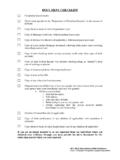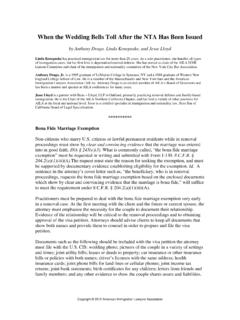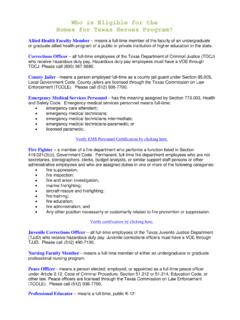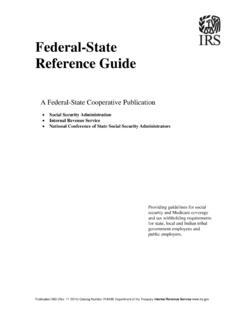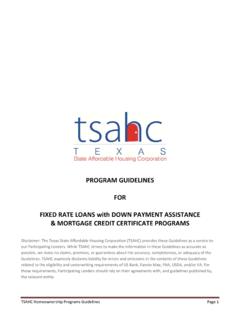Transcription of When and How to Prepare an L-1A Function …
1 1 Copyright 2012 American Immigration Lawyers Association when and How to Prepare an L-1A Function Manager Petition by Lisa Krueger Khan and Cyrus Mehta with edits by Samuel Adair Sam Adair has practiced immigration law for the last decade. He focuses on employment-based immigration ranging from visa processing, permanent residence, employer compliance issues, and mergers and acquisitions. Mr. Adair works with employers of all sizes on immigration and compliance issues. His practice is based in Austin, TX with satellite offices in Silicon Valley and Atlanta.
2 Lisa Krueger Khan has practiced immigration law (primarily business and family immigration) since 1997. She has served on the AILA Central Florida Chapter s board since 2002, most recently as chair. She also serves on the AILA National Field Operations Liaison Committee. Ms. Khan holds a in Business Administration/Political Science (Principia College) and a and in Political Science from the University of Michigan. Cyrus D. Mehta is the managing attorney of Cyrus D. Mehta & Associates, PLLC. Mr. Mehta is the Vice-Chair of AILA s Ethics Committee, past Chair of AILA s National Pro Bono Committee and former Chair of the Board of Trustees of the American Immigration Council (2004 06).
3 He received the AILA 2011 Michael Maggio Memorial Award for his outstanding efforts in providing pro bono representation in the immigration field. Mr. Mehta is a frequent speaker on contemporary immigration issues and author of several influential articles, including on ethics. ** This practice pointer will focus on when and how an L-1A petition should be prepared for an employee who has or will manage an essential Function within an organization. This type of manager is commonly referred to as a Function manager.
4 Both the statutory definitions of manager under INA 101(a)(44)(A) and executive under 101(a)(44)(B) provide a basis to qualify the employee as managing a Function or major component within the organization. While the ability to manage a Function should allow an entrepreneur in a small business to qualify, the USCIS has taken a restrictive view of who can qualify as a Function manager, which has been upheld by the courts. For example, in Brazil Quality Stones v. Chertoff, 531 1063 (9th Cir. 2008), the Ninth Circuit upheld the AAO s view that the evidence did not compel that the beneficiary primarily performed managerial duties in a small company.
5 The size of the business does indeed matter in the L-1A context, and the USCIS will assume that in a small business, the manager will be performing non-qualifying duties. Still, it is possible to win an L-1A if the careful practitioner is mindful of certain details, which we will discuss in this advisory. In evaluating your L-1A case, carefully review the definitions of managerial capacity and executive capacity in both the statute, supra, and the regulations at 8 CFR (l)(1)(ii)(B) and (C). If at all possible-- and this is more likely when dealing with an L-1A new office case or smaller companies-- try to classify your L-1A employee as an executive rather than as a manager.
6 Because the definition of executive capacity is less complex and more straightforward than that of managerial capacity, the elements of executive capacity are generally much easier to prove. Pursuant to INA 101(a)(44)(B) the term executive capacity means an assignment within an organization in which the employee primarily: i) directs the management of the organization or a major component or Function of the organization; 2 Copyright 2012 American Immigration Lawyers Association ii) establishes the goals and policies of the organization, component or Function ; iii) exercises wide latitude in discretionary decision-making.
7 And iv) receives only general supervision or direction from higher level executives, the board of directors, or stock holders of the organization. Once you determine the appropriate classification, be consistent in your documentation. Do not refer to the L-1A beneficiary as an executive/ manager. Choose your definition and then prove in your documentation each element of the relative definition. Immigration will often incorrectly use the terms executive and manager interchangeably and/or commingle the definitions of both terms.
8 For example, if you receive an RFE asking for proof that your executive controls the work of other supervisory, professional or managerial employees, do not hesitate to respectfully point out to the requesting officer that the definitions of executive capacity and managerial capacity are statutorily distinct and underscore that the beneficiary is an executive and not a manager. There is no need to prove that your executive is a manager or vice versa. If it is not possible to classify the L-1A beneficiary as an executive, carefully review the four criteria in the definition of managerial capacity.
9 To qualify as an L-1A manager, all four components of the definition must be met. Pursuant to INA 101(a)(44)(A), the position must be one in which the employee primarily: i) Manages the organization, or a department, subdivision, Function , or component of the organization; ii) Supervises and controls the work of other supervisory, professional, or managerial employees, or manages an essential Function within the organization, or a department or subdivision of the organization; iii) Has the authority to hire and fire or recommend those as well as other personnel actions (such as promotion and leave authorization) if another employee or other employees are directly supervised; if no other employee is directly supervised, functions at a senior level within the organizational hierarchy or with respect to the Function managed; and iv) Exercises direction over the day-to-day operations of the activity or Function for which the employee has authority.
10 A first-line supervisor is not considered to be acting in a managerial capacity merely by virtue of the supervisor s supervisory duties unless the employees supervised are professional. Note first the word primarily in the definition. It will not be enough that the manager is partially engaged in the tasks above; he/she must primarily be engaged in such activity. As a general guideline, primarily usually means more than 50% of the time. To this end, be sure to attach a percentage of time to each of the managerial job duties in which the beneficiary will engage.


